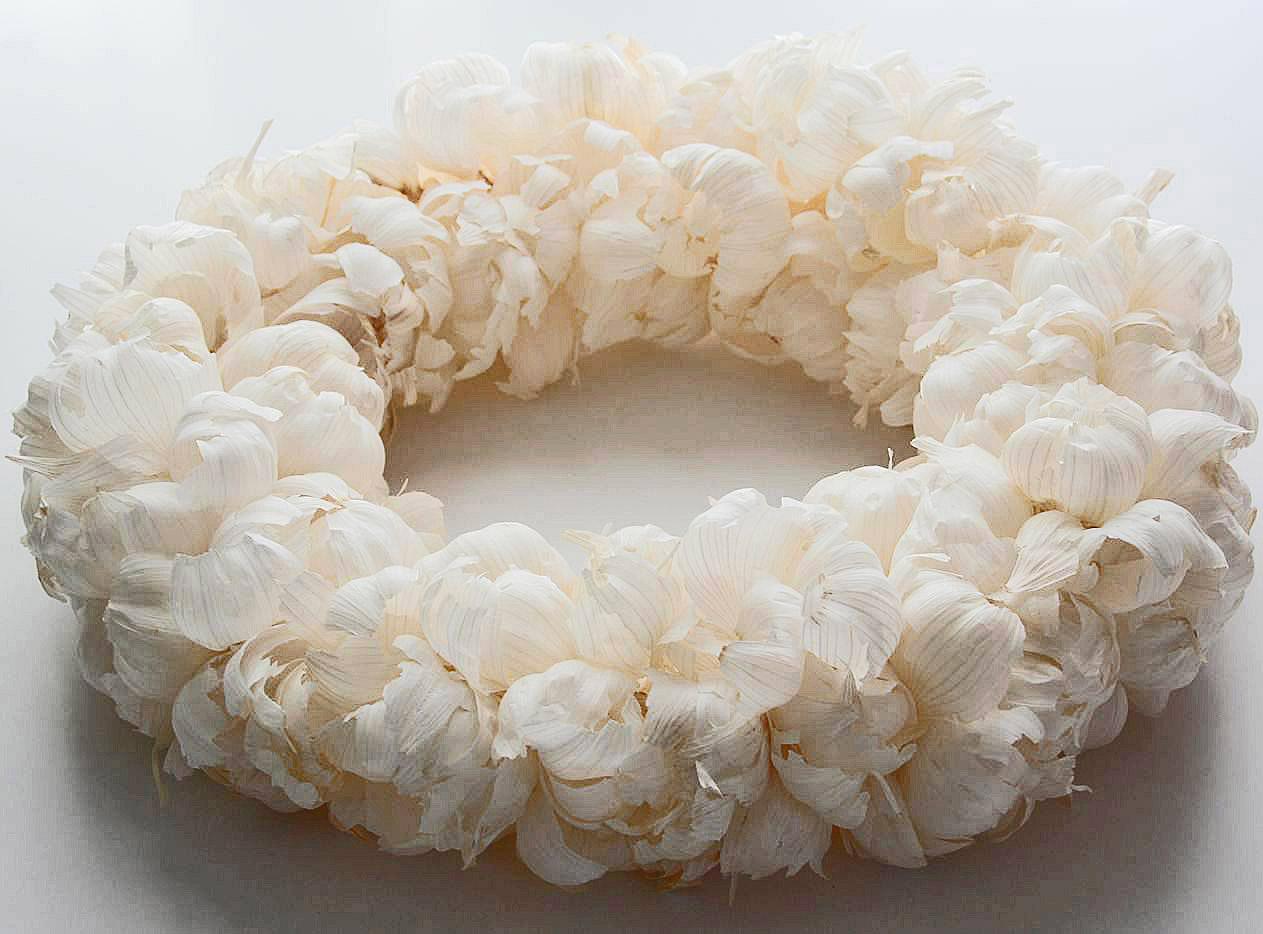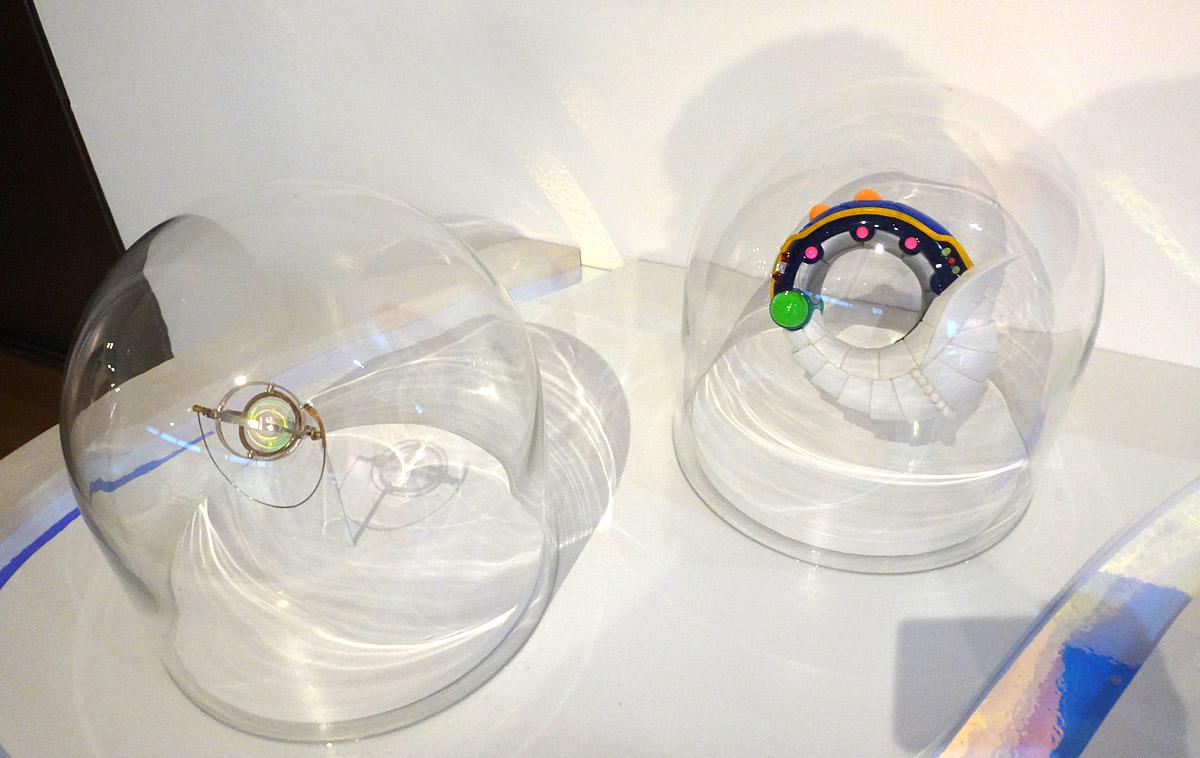
Magnetized 3D phosphorescent brooches
Photos: Laurel Marcus
It’s been 20 years since we thought the world would be ending – remember how we feared everyone’s computer would glitch, flights would be suspended mid-air and all manner of chaos would ensue. I’m still grappling with how all that time passed – now throw this exhibition at MAD into the mix. Interpreting conceptual Y2K jewelry for someone born, shall we say, pre-internet, is terrifying. Even Sotheby’s SVP/ preeminent expert/ jeweler to the stars Frank Everett who was our Sotheby’s liaison last evening at the Museum of Arts and Design said he was here to learn. MAD Curator Kellie Riggs assisted by Guest Curator Barbara Paris Gifford led a tour of Non-Stick Nostalgia: Y2K Retrofuturism in Contemporary Jewelry (March 21 – July 21) featuring 29 makers born between 1977-1985. I brought a Millennial (my son) with me to (hopefully) translate.

Jewelry made from melted eye glasses
“It’s about a new generation getting a voice,” Gifford explained. Several factors influenced this type of contemporary jewelry including “proliferation of new materials after the war, Bauhaus leaders coming to the U.S., and the G.I. bill which paid for art school for veterans.” This jewelry and its makers rejected the formerly commonplace use of precious metals and stones inviting jewelry to become a “more democratic pursuit.”

Photo by Veronika Vidø, courtesy the artist
Mentioning the garlic peel collar necklace by Verena Sieber-Fuchs on view in MAD Collects (till March 31) she posed the question of size and materials used, what constitutes jewelry and how it’s been elevated to an art form. Why do we wear something and what does it say about us? Of course, each generation must rebel against the inclination in the field – this one has additional identity issues to deal with thanks to our “ever-evolving digital labyrinth,” including social media and the re-creation of one’s “actualized” self in person versus online.

The exhibition is divided into three sections: Future Past, Gen Friction, and Hyperreality. There are also some exciting pieces from MAD’s permanent collection presenting “a historical view of aesthetics in Futurism in jewelry.” Future Past deals with a Pre-Y2K aesthetic; “pieces archetypal at their core” such as friendship necklaces, smileys, shiny rings and chains – a mixture of classic jewelry tropes, hip-hop and pop culture references. “By conjuring a feeling of youthful exploration and self-reconciliation, Future Past makes a fumbling statement about the fragmented free fall of identity formation, recalling a time of discovery when fewer were watching,” according to the wall text.

Gen Friction are those artists in the middle – “they’re innovative and accept technology but have a memory of the way things were before the digitalized memory,” according to Gifford. They may use and embrace 3D digital processes while still feeling nostalgia for the analog simplicities of their childhood. There’s a duality: “a sense of hope, as well as hints of nihilism.”

Hyperreality deals with “a realm of high fantasy and implied futuristic functionality,” which is “potent enough to combat the darkest spirals of an increasingly image-based, digitized world.” Here you’ll find the humanoid virtual robots, (I hesitate to use the term A.I. such as fembot @lilmiquela) who has IG influencers looking just like her – the URL (web) versus IRL (real life) hybridity. “Millennials have been raised cyborg, and they know they are being viewed. Unable to escape, nor necessarily willing, they represent themselves with a new kind of adornment to offset the pressure.”

Curator Riggs is herself an artist – she has met nearly every one of these makers at Munich Jewellry Week billed as “a week dedicated to the most exquisite contemporary jewellry” which took place earlier this month. Along with her curation, she also dyed and bleached many of the backdrops for these installations (the traditional white jewelry cube gets an update) as well as the fabric on the benches in the room. Riggs took us through the exhibition pointing out various themes that are expressed by its maker. “Who do you become when you wear something? Do (U2) Bono’s glasses give him confidence? Who would he be without them? It’s a self-schema,” she explained. I guess we old schoolers might call it a trademark. Food for thought: could it be a superpower like Superman’s cape? The idea of memory is also called into question: Computers have memory but isn’t it a play on memory with friendship jewelry – you have shared memories with a friend?

Curator Kellie Riggs
The idea of nostalgia in the title refers to the notion that “anything can be made new quickly and come back.” Beatrice Brovia’s works deal with adornment and sports culture – the idea of “receiving something to wear as a result of your success.” According to Riggs, Annika Pettersson’s “Glitch in the Copy” drew scathing reviews from an earlier viewer who just didn’t get it. Pettersson’s four brooches on display illustrate what happens when you copy ad infinitum. The artist digitally modeled the silhouette of a classic Victoria brooch, 3D-printed it in aluminum, 3D-scanned the print, and then 3D-printed the scan, twelve times over. “With each pass, the integrity of the copy is compromised through degradation and generational distortion” known as “acquired noise.” According to Gifford, this represents a feeling of technology disappointing us ergo nihilism. Darja Popolitova has said of her tactile, fluid shaped Narcissus brooches (plastic, silver, and chromed steel) that she likes the safety of wearing her jewelry on the internet but not in real life.

Ines Alpha (@inesalpha) uses iridescent 3D makeup in videos in her art form much as Rick Owens did in his Fall 2019 runway show featuring facial augmentation. “There’s something alien-like about their faces. We used to see people with green or blue hair online, but now you see it everywhere. People’s internet or personal selves and their real selves are now merging,” added Gifford. “It’s a journey — whatever they’ve explored on Snapchat is working itself out in jewelry.”
